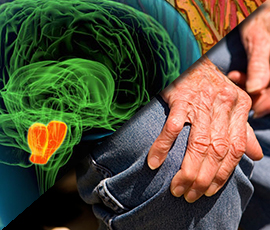 Parkinson's disease is the second most common neurodegenerative disorder and the most common movement disorder. It is characterized by progressive loss of muscle control, which leads to trembling of the limbs and head while at rest, stiffness, slowness, and impaired balance.
Parkinson's disease is the second most common neurodegenerative disorder and the most common movement disorder. It is characterized by progressive loss of muscle control, which leads to trembling of the limbs and head while at rest, stiffness, slowness, and impaired balance.
As symptoms worsen, it may become difficult to walk, talk, and complete simple tasks.
Most individuals who develop Parkinson's disease are 60 years of age or older. Since overall life expectancy is rising, the number of individuals with Parkinson's disease will increase in the future.
Adult-onset Parkinson's disease is most common, but early-onset Parkinson's disease (onset between 21-40 years), and juvenile-onset Parkinson's disease (onset before age 21) also exist.
Causes of Parkinson's disease facts:
A substance called dopamine acts as a messenger between two brain areas, the substantia nigra and the corpus striatum to produce smooth, controlled movements.
Most of the movement-related symptoms of Parkinson's disease are caused by a lack of dopamine due to the loss of dopamine-producing cells in the substantia nigra. When the amount of dopamine is too low, communication between the substantia nigra and corpus striatum becomes ineffective, and movement becomes impaired; the greater the loss of dopamine, the worse the movement-related symptoms.
Other cells in the brain also degenerate to some degree and may contribute to non-movement related symptoms of Parkinson's disease.
Although it is well known that lack of dopamine causes the motor symptoms of Parkinson's disease, it is not clear why the dopamine-producing brain cells deteriorate.
Causes of Parkinson´s disease:
Genetic and pathological studies have revealed that various dysfunctional cellular processes, inflammation, and stress can all contribute to cell damage. In addition, abnormal clumps called Lewy bodies, which contain the protein alpha-synuclein, are found in many brain cells of individuals with Parkinson's disease. The function of these clumps in regards to Parkinson's disease is not understood. In general, scientists suspect that dopamine loss is due to a combination of genetic and environmental factors.
Other causes of Parkinsonism:
•An adverse reaction to prescription drugs
•Use of illegal drugs
•Exposure to environmental toxins
•Stroke
•Thyroid and parathyroid disorders
•Repeated head trauma (for example, the trauma associated with boxing and multiple concussions)
•Brain tumor
•An excess of fluid around the brain (called hydrocephalus)
•Brain inflammation (encephalitis) resulting from infection
Parkinsonism may also be present in persons with other neurological conditions, including Alzheimer's, Lewy body disease, Creutzfeldt-Jakob disease, Wilson's disease, and Huntington's disease.
Genes linked to Parkinson's disease
In most individuals, Parkinson's disease is idiopathic, which means that it arises sporadically with no known cause.
However, some of individuals diagnosed with Parkinson’s also have family members with the disease.
By studying families with hereditary Parkinson's disease, scientists have identified several genes that are associated with the disorder.
Studying these genes helps understand the cause of Parkinson's disease and may lead to new therapies. So far, five genes have been identified that are definitively associated with Parkinson's disease.
•SNCA (synuclein, alpha non A4 component of amyloid precursor)
•PARK2 (Parkinson's disease autosomal recessive, juvenile 2): The PARK2 gene makes the protein parkin.
•PARK7 (Parkinson's disease autosomal recessive, early onset 7): PARK7 mutations are found in early-onset Parkinson's disease.
•PINK1 (PTEN-induced putative kinase 1): Mutations of this gene are found in early-onset Parkinson's disease.
•LRRK2 (leucine-rich repeat kinase 2): LRRK2 makes the protein dardarin.
•Several other chromosome regions and the genes GBA (glucosidase beta acid), SNCAIP (synuclein alpha interacting protein), and UCHL1 (ubiquitin carboxyl-terminal esterase L1) may also be linked to Parkinson's disease.
Primary motor signs of Parkinson’s disease:
•tremor of the hands, arms, legs, jaw and face
•bradykinesia or slowness of movement
•rigidity or stiffness of the limbs and trunk
•postural instability or impaired balance and coordination
Other Symptoms:
•Changes in memory, concentration and judgement
•Trouble interpreting visual information
•Muffled speech
•Visual hallucinations
•Delusions, especially paranoid ideas
•Depression
•Irritability and anxiety.
•Sleep disturbances, including excessive daytime drowsiness and rapid eye movement (REM) sleep disorder
Current treatments for Parkinson’s include the drug Levodopa, which was discovered in the 1960s. It is converted into dopamine in the body, so it acts as a stand-in for the lost dopamine-producing neurons. Some other drugs act like dopamine to stimulate the nerve cells. Patients are also treated with occupational therapy, physiotherapy, healthy diet and exercise.
Surgery, such as deep brain stimulation with implanted electrodes, is used to treat more advanced cases, especially in those where the drugs are working less well.
These treatments relieve the symptoms of Parkinson's disease, but do not slow down or reverse the damage to nerve cells in the brain. Over time, the clinical features get worse despite treatment.
By the time patients are diagnosed with Parkinson’s they have often had the disease for years and have lost over half of the dopamine cells within the nigra. Tests that detect Parkinson’s earlier may help, but scientists are searching for a way to replace the damaged cells.
Although the underlying cause of Parkinson's disease is unknown, scientists do know which cells and areas of the brain are involved.
We are using stem cells (autologous) to grow dopamine-producing nerve cells, especially in those cases where there is a known genetic cause for the condition. Because a single, well-defined type of cell is affected, it may also be possible to treat Parkinson’s by replacing the lost nerve cells with healthy new ones.

Av. Masferrer South. Urb. Maquilishuat No. 1006. San Salvador, El Salvador. CA.
(503) 2268-5999 Fax. 2268-5910
www.stemcell-elsalvador.com - info@stemcell-elsalvador.com